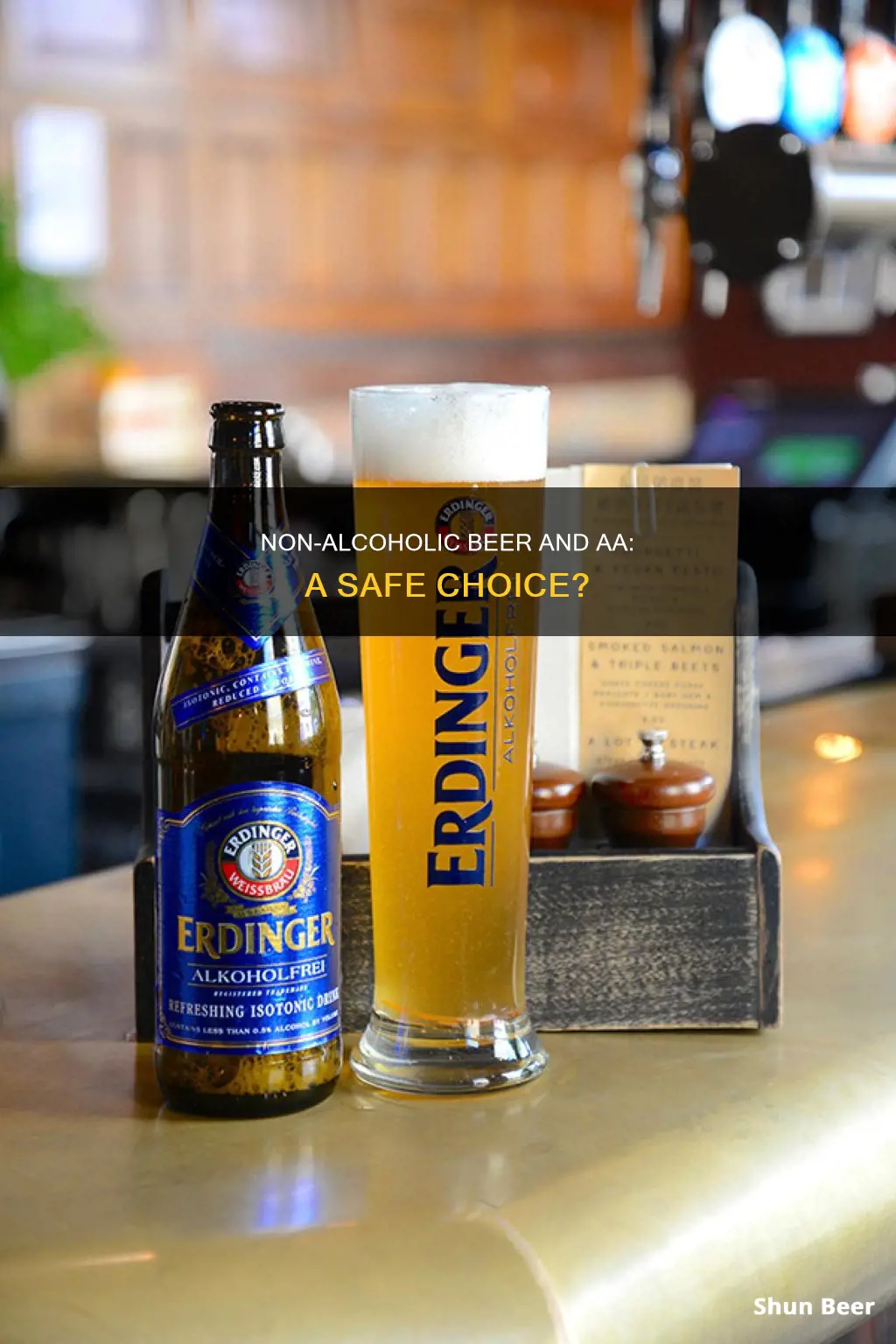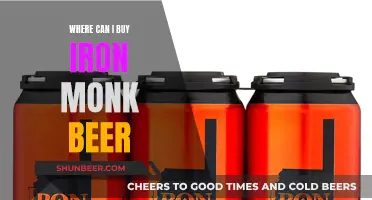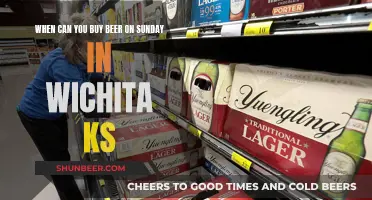
Whether or not someone in Alcoholics Anonymous (AA) can buy non-alcoholic beer is a complex question. In the US, non-alcoholic beer is defined as containing less than 0.5% alcohol by volume (ABV). While non-alcoholic beer has far less alcohol content than regular beer, it is not completely alcohol-free. For some in recovery, this small alcohol content may be enough to trigger a relapse. However, for others, non-alcoholic beer can provide a sense of normalcy and inclusion in social settings where alcohol is present. The decision to consume non-alcoholic beer during sobriety is usually a personal one, and it is important to carefully consider one's triggers and how consuming non-alcoholic beer may be perceived by peers within support groups and the sober community.
| Characteristics | Values |
|---|---|
| Federal Law in the USA | Non-alcoholic beer must contain 0.5% or less alcohol by volume (ABV) |
| State Law in the USA | Varies, but in some states, minors are allowed to buy non-alcoholic beer |
| UK Law | No ID needed to buy alcohol under 0.5% ABV |
| Health Benefits | Non-alcoholic beer is far more organic and wholesome than full-alcohol lagers |
| Addiction Risks | For some recovering alcoholics, non-alcoholic beer can be a trigger and a slippery slope back into drinking alcoholic beverages |
What You'll Learn
- Non-alcoholic beer laws vary across US states
- Non-alcoholic beer may be considered a relapse by some
- Non-alcoholic beer may trigger cravings for alcoholic beverages
- Non-alcoholic beer can help recovering alcoholics feel included in social situations
- Non-alcoholic beer may be perceived as a slippery slope to full relapse

Non-alcoholic beer laws vary across US states
Kentucky and Vermont, for example, classify non-alcoholic beer at an ABV higher than 0.5%, allowing up to 1.0% ABV. On the other hand, states like New York, Tennessee, Georgia, and Idaho regard any beer containing alcohol as an alcoholic beverage, so their alcohol laws also apply to non-alcoholic beer. In these states, it is not advisable to consume non-alcoholic beer in situations where alcoholic beverages are prohibited.
Most other states mirror federal non-alcoholic beer laws, classifying beer with an alcohol content of no more than 0.5% ABV as non-alcoholic. However, the laws vary when it comes to the purchase of non-alcoholic beer by minors. While federal law prohibits the sale of alcoholic beverages to those under 21, some states have different rules for non-alcoholic beer.
In Ohio, for instance, individuals must be over 18 to purchase non-alcoholic beer, while in Oregon, West Virginia, and Wyoming, individuals under 21 cannot purchase non-alcoholic beer with 0.5% ABV or above. In Alabama, the sale of non-alcoholic beer is not regulated in wet counties but is prohibited in dry counties.
Some states allow minors to consume non-alcoholic beer under certain conditions, such as parental permission or supervision. These states include Alabama, Louisiana, Mississippi, New Mexico, North Carolina, North Dakota, Ohio, Oklahoma, Oregon, West Virginia, and Wyoming.
It's worth noting that while non-alcoholic beer is generally allowed to be consumed while driving, specific laws vary by state, and open container laws may apply. Additionally, some retailers may have their own policies regarding the sale of non-alcoholic beer to minors, requiring them to be of legal drinking age or present valid ID.
Cheapest Beer: Where to Buy and Save
You may want to see also

Non-alcoholic beer may be considered a relapse by some
Non-alcoholic beer is a controversial topic in the recovery community. While some people believe that it can be a valuable tool for social integration, helping individuals avoid alcohol without drawing attention to their abstinence, others argue that it is a slippery slope that can trigger a relapse.
The ritual of drinking beer, including the sound of cracking open a can, the smell, and the sensation of holding a cold, condensation-beaded glass, can stimulate the reward centres of the brain and release dopamine. This can lead to "euphoric recall", where individuals romanticise their previous drinking and forget the negative consequences. Additionally, the taste and ritual of drinking beer, even without alcohol, can act as a psychological trigger, potentially leading to cravings for alcoholic beverages.
Some people in recovery view non-alcoholic beer as a valuable alternative that allows them to occasionally enjoy a drink while still maintaining sobriety. It can provide a sense of normalcy and inclusion in social settings where alcohol is present, helping them feel like they are not missing out.
However, others argue that non-alcoholic beer should be avoided entirely. They believe that the risks of triggering a relapse outweigh the benefits. This is especially true for individuals who are hypersensitive to any sensations or rituals associated with alcohol.
Ultimately, the decision to consume non-alcoholic beer during sobriety is a personal one. It is crucial to carefully reflect on your reasons, definition of sobriety, potential physical and psychological effects, and discuss it with your support network.
Best Beer Stores in Connecticut
You may want to see also

Non-alcoholic beer may trigger cravings for alcoholic beverages
Non-alcoholic beer is often presented as a safe alternative to alcohol, but it's important to be aware of the risks before trying it. While non-alcoholic beer might be a good option for some, it comes with potential dangers, especially for those recovering from alcohol use disorder.
The smell and taste of non-alcoholic beer can trigger cravings and a subsequent relapse among certain people with alcohol use disorder. A team of California scientists reported that the smell of beer may be enough to trigger cravings and a subsequent relapse. In their study, rats were trained to self-administer alcohol when they smelled banana. The researchers found increases in dopamine in the rats' brains before and after smelling these "alcohol-related cues."
For individuals in recovery from alcohol addiction, consuming non-alcoholic beer may trigger a relapse due to its slight alcohol content. Even though the amount of alcohol is minimal, it can still activate cravings and lead to a full-blown relapse. It is recommended that recovering alcoholics avoid non-alcoholic beer entirely to prevent any potential risks.
The taste, smell, and ritualistic behavior associated with drinking regular beer can trigger cravings and make it difficult for those in recovery to maintain their sobriety. Non-alcoholic beer may also give a false sense of security and lead individuals to believe that they can consume larger quantities without any consequences. This mentality can be dangerous and potentially result in relapse.
Additionally, for those who have struggled with alcohol addiction in the past, drinking non-alcoholic beer might trigger cravings or lead to a relapse if it reactivates old behavioral patterns. It is important for individuals in alcohol recovery to consult with their healthcare provider, therapist, or addiction specialist before consuming non-alcoholic beer or any other products that may resemble alcoholic beverages.
Lupulin Beer: Where to Buy and Enjoy It
You may want to see also

Non-alcoholic beer can help recovering alcoholics feel included in social situations
Non-alcoholic beer has gained popularity in recent years, with sales of non-alcoholic beer in the USA surging by 37% in 2020. This popularity is due in part to people becoming "sober curious" and wanting to try abstaining from alcohol, as well as the healthier characteristics and decreased calories of non-alcoholic drinks.
Non-alcoholic beer is defined as containing less than 0.5% alcohol by volume (ABV). This means that it would take about 10 non-alcoholic beers to equal the alcohol content of one regular beer. While this is a very low alcohol content, it is important to note that non-alcoholic beer does still contain alcohol.
For recovering alcoholics, non-alcoholic drinks can provide a sense of normalcy and inclusion in social settings where alcohol is present. It allows them to participate in the social ritual of drinking without compromising their sobriety goals. It can help them feel included and part of the group, rather than feeling awkward or excluded, without posing a risk to their recovery.
However, it is important to be aware of the potential risks of non-alcoholic drinks for recovering alcoholics. The taste, smell, and sensation of non-alcoholic beer can act as a trigger for some people, stimulating the reward centres of the brain and leading to cravings for alcoholic beverages. It can also cause "euphoric recall", where people romanticise their previous drinking and forget the negative consequences it had on their lives.
The decision of whether to consume non-alcoholic beer during recovery is a personal one, and it is important for individuals to carefully consider their own triggers and motivations. While non-alcoholic beer can help some people feel included in social situations, for others it may be a trigger and lead to a dangerous relapse.
Buying Beer in Virginia on Thanksgiving: What's the Deal?
You may want to see also

Non-alcoholic beer may be perceived as a slippery slope to full relapse
Non-alcoholic beer is a controversial topic among those in recovery from alcohol addiction. While some people believe that it can be a valuable tool for moderating alcohol intake, others argue that it poses a significant risk of triggering a relapse. This is particularly true for individuals in recovery programs, who typically avoid any substances containing traceable amounts of alcohol.
The potential risks associated with non-alcoholic beer lie in its ability to trigger cravings and stimulate the reward centres of the brain. The smell, taste, and even the sound of opening a can of non-alcoholic beer can evoke powerful sensory memories and stimulate dopamine release, leading to what is known as "euphoric recall". This can cause a weakening in an individual's commitment to sobriety and increase the likelihood of relapse.
The ritual of drinking beer, including the act of opening a bottle or can, the sound of the pop, and the condensation on the glass, can be powerful triggers for people in recovery. The very name "beer" and the association with relaxation and socialisation can also evoke the anticipation of drinking and cause salivation. These sensory cues and psychological triggers can be a slippery slope for those working towards maintaining their sobriety.
Additionally, the concept of "near beer" or "alcohol-free" beer can be misleading. While these beverages contain significantly less alcohol than regular beer, they are not entirely alcohol-free. According to federal law, non-alcoholic beer can contain up to 0.5% alcohol by volume (ABV). This is still enough to have an effect on individuals who are highly sensitive to alcohol or who are triggered by any amount of alcohol consumption.
Furthermore, a study published in the Canadian Journal of Clinical Pharmacology found that out of 45 non-alcoholic beers, 13 (29%) had ethanol levels higher than declared on their labels, and 6 beverages claiming to be alcohol-free contained more than 1% ethanol. This underscores the importance of caution when considering non-alcoholic beer as a recovery-safe alternative.
Ultimately, the decision to consume non-alcoholic beer during recovery is a personal one. It is crucial for individuals to be aware of their triggers and to exercise self-examination. While some may find that non-alcoholic beer helps them feel included in social situations, others may view it as a dangerous loophole that could jeopardise their hard-earned progress.
Buying Beer on Easter Sunday in Georgia: What's Allowed?
You may want to see also
Frequently asked questions
It depends on the individual and their recovery. While non-alcoholic beer is widely available, it does contain a small amount of alcohol and can be a psychological trigger for some people in recovery.
In the US, non-alcoholic beer is defined as containing less than 0.5% alcohol by volume (ABV). This is a legal requirement for any beverage to be considered non-alcoholic.
Non-alcoholic beer can provide a sense of normalcy and inclusion in social settings where alcohol is present. It allows individuals to participate in the social ritual of drinking without compromising their sobriety goals. However, for some people, the taste and ritual of drinking beer, even without alcohol, can act as a trigger, potentially leading to cravings for alcoholic beverages.







